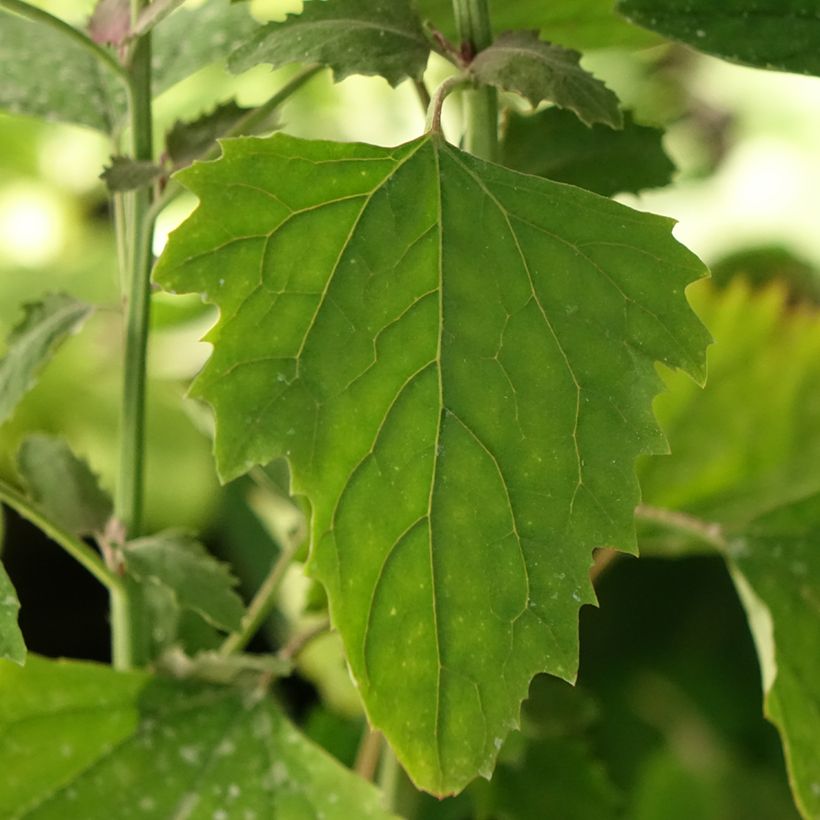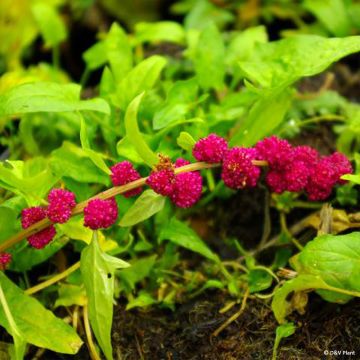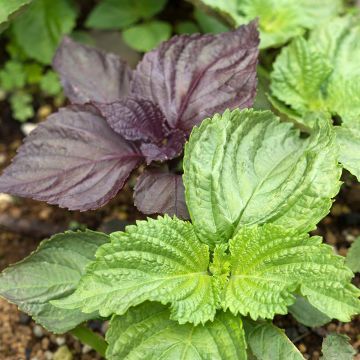

Tree Spinach - Chenopodium giganteum
Tree Spinach - Chenopodium giganteum
Chenopodium giganteum
Tree Spinach
Special offer!
Receive a €20 voucher for any order over €90 (excluding delivery costs, credit notes, and plastic-free options)!
1- Add your favorite plants to your cart.
2- Once you have reached €90, confirm your order (you can even choose the delivery date!).
3- As soon as your order is shipped, you will receive an email containing your voucher code, valid for 3 months (90 days).
Your voucher is unique and can only be used once, for any order with a minimum value of €20, excluding delivery costs.
Can be combined with other current offers, non-divisible and non-refundable.
Why not try an alternative variety in stock?
View all →This plant carries a 6 months recovery warranty
More information
We guarantee the quality of our plants for a full growing cycle, and will replace at our expense any plant that fails to recover under normal climatic and planting conditions.
Description
Tree Spinach is a large annual plant with a bush-like appearance, also known as Amaranthus-coloured goosefoot due to its young magenta-coloured leaves. Considered as a forgotten vegetable, it is a decorative, vigorous, and undemanding plant. It is cultivated for its young leaves used in mesclun salads and its mature leaves that can be consumed raw in salads or cooked like spinach. The seeds can be prepared like rice or quinoa. It is planted in spring, in partial shade or shade, or even in the sun in the north, in ordinary soil, even limestone.
Chenopodium giganteum belongs to the amaranth family according to classifications. It is an annual plant native to northern India, Nepal, and the Chinese province of Sichuan. It was introduced to France in the 19th century. In the course of a year, it forms a ramified bush that easily reaches 1.50m (5ft) in height, even 2m (7ft).
The plant has numerous branches that end in small, hairy, and decorative leaves, ranging in color from pink to bright red. The mature leaves are green. They are diamond-shaped to oval and measure up to 20cm (8in) in length and 16cm (6in) in width. Flowering begins in August. It takes the form of terminal inflorescences in greenish panicles. After wind pollination, numerous small seeds measuring 1.5mm (0in) in diameter are formed, sought after by birds. This goosefoot self-seeds spontaneously.
It is an original and tasty medicinal, ornamental, and vegetable plant that can be prepared in a thousand ways: young leaves or mature leaves in small quantities can be consumed raw in spring salads, in mesclun salads, in Japanese tempura, quickly cooked in a wok, or even in a savory tart with small pieces of goat cheese or salmon. The leaves contain oxalic acid and saponins, which are mostly eliminated during the cooking process, especially if boiled for 2 minutes at 100°C (212°F).
Harvest: Leaf harvest should be done according to their growth and your needs. In summer, the leaves become too tough to be consumed, but the young flower stalk can be enjoyed in the same way as asparagus.
Storage: The leaves do not keep well in the refrigerator as they tend to soften. It is best to consume them a few hours after harvesting.
Gardener's tip: Prune the young plants to give them a bush-like shape. The further south, the more the tree spinach will be sheltered from the scorching sun.
Report an error about the product description
Tree Spinach - Chenopodium giganteum in pictures


Harvest
Plant habit
Foliage
Other Spinach
View all →Planting and care
The tree spinach easily self-seeds from one year to the next, as the plant produces numerous seeds. We recommend keeping some seeds to sow them in a warm place at the end of winter, for planting after the last frost. Chenopodium giganteum, although undemanding, particularly likes deep, loose, well-prepared soils that remain slightly moist. It also prefers sunny locations in the north, but more shaded ones in southern regions. You can increase leaf production by removing the flower stalks. To obtain a sufficient harvest, 2 or 3 plants will be enough in your vegetable garden. Don't hesitate to plant it among radishes, lettuces, orach, and coriander.
Cultivation
Care
Intended location
This item has not been reviewed yet - be the first to leave a review about it.
Similar products
Haven't found what you were looking for?
Hardiness is the lowest winter temperature a plant can endure without suffering serious damage or even dying. However, hardiness is affected by location (a sheltered area, such as a patio), protection (winter cover) and soil type (hardiness is improved by well-drained soil).

Photo Sharing Terms & Conditions
In order to encourage gardeners to interact and share their experiences, Promesse de fleurs offers various media enabling content to be uploaded onto its Site - in particular via the ‘Photo sharing’ module.
The User agrees to refrain from:
- Posting any content that is illegal, prejudicial, insulting, racist, inciteful to hatred, revisionist, contrary to public decency, that infringes on privacy or on the privacy rights of third parties, in particular the publicity rights of persons and goods, intellectual property rights, or the right to privacy.
- Submitting content on behalf of a third party;
- Impersonate the identity of a third party and/or publish any personal information about a third party;
In general, the User undertakes to refrain from any unethical behaviour.
All Content (in particular text, comments, files, images, photos, videos, creative works, etc.), which may be subject to property or intellectual property rights, image or other private rights, shall remain the property of the User, subject to the limited rights granted by the terms of the licence granted by Promesse de fleurs as stated below. Users are at liberty to publish or not to publish such Content on the Site, notably via the ‘Photo Sharing’ facility, and accept that this Content shall be made public and freely accessible, notably on the Internet.
Users further acknowledge, undertake to have ,and guarantee that they hold all necessary rights and permissions to publish such material on the Site, in particular with regard to the legislation in force pertaining to any privacy, property, intellectual property, image, or contractual rights, or rights of any other nature. By publishing such Content on the Site, Users acknowledge accepting full liability as publishers of the Content within the meaning of the law, and grant Promesse de fleurs, free of charge, an inclusive, worldwide licence for the said Content for the entire duration of its publication, including all reproduction, representation, up/downloading, displaying, performing, transmission, and storage rights.
Users also grant permission for their name to be linked to the Content and accept that this link may not always be made available.
By engaging in posting material, Users consent to their Content becoming automatically accessible on the Internet, in particular on other sites and/or blogs and/or web pages of the Promesse de fleurs site, including in particular social pages and the Promesse de fleurs catalogue.
Users may secure the removal of entrusted content free of charge by issuing a simple request via our contact form.
The flowering period indicated on our website applies to countries and regions located in USDA zone 8 (France, the United Kingdom, Ireland, the Netherlands, etc.)
It will vary according to where you live:
- In zones 9 to 10 (Italy, Spain, Greece, etc.), flowering will occur about 2 to 4 weeks earlier.
- In zones 6 to 7 (Germany, Poland, Slovenia, and lower mountainous regions), flowering will be delayed by 2 to 3 weeks.
- In zone 5 (Central Europe, Scandinavia), blooming will be delayed by 3 to 5 weeks.
In temperate climates, pruning of spring-flowering shrubs (forsythia, spireas, etc.) should be done just after flowering.
Pruning of summer-flowering shrubs (Indian Lilac, Perovskia, etc.) can be done in winter or spring.
In cold regions as well as with frost-sensitive plants, avoid pruning too early when severe frosts may still occur.
The planting period indicated on our website applies to countries and regions located in USDA zone 8 (France, United Kingdom, Ireland, Netherlands).
It will vary according to where you live:
- In Mediterranean zones (Marseille, Madrid, Milan, etc.), autumn and winter are the best planting periods.
- In continental zones (Strasbourg, Munich, Vienna, etc.), delay planting by 2 to 3 weeks in spring and bring it forward by 2 to 4 weeks in autumn.
- In mountainous regions (the Alps, Pyrenees, Carpathians, etc.), it is best to plant in late spring (May-June) or late summer (August-September).
The harvesting period indicated on our website applies to countries and regions in USDA zone 8 (France, England, Ireland, the Netherlands).
In colder areas (Scandinavia, Poland, Austria...) fruit and vegetable harvests are likely to be delayed by 3-4 weeks.
In warmer areas (Italy, Spain, Greece, etc.), harvesting will probably take place earlier, depending on weather conditions.
The sowing periods indicated on our website apply to countries and regions within USDA Zone 8 (France, UK, Ireland, Netherlands).
In colder areas (Scandinavia, Poland, Austria...), delay any outdoor sowing by 3-4 weeks, or sow under glass.
In warmer climes (Italy, Spain, Greece, etc.), bring outdoor sowing forward by a few weeks.






















































